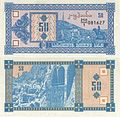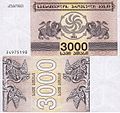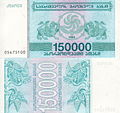Georgian kuponi
Former currency of Georgia, used 1993-1995 From Wikipedia, the free encyclopedia
The kuponi (Georgian: კუპონი k’up’oni, "coupon"; ISO 4217: GEK) was the currency of Georgia. It was introduced on 5 April 1993, replacing the Russian ruble at par. This currency was temporary, with no coins nor subdivisions. It also suffered from hyperinflation.
This article needs additional citations for verification. (March 2021) |
| ქართული კუპონი (Georgian) | |
|---|---|
 1 million kuponi (1 lari; 1994) | |
| ISO 4217 | |
| Code | GEK |
| Plural | The language(s) of this currency do(es) not have a morphological plural distinction. |
| Denominations | |
| Banknotes | 1, 3, 5, 10, 50, 100, 250, 500, 1,000, 2,000, 3,000, 5,000, 10,000, 20,000, 25,000, 30,000, 50,000, 100,000, 150,000, 250,000, 500,000, 1,000,000 kuponi |
| Demographics | |
| Date of introduction | 5 April 1993 |
| Replaced | Russian rouble (1 RUR = 1 GEK) |
| Date of withdrawal | 2 October 1995 |
| Replaced by | Georgian lari (1 GEL = 1,000,000 GEK) |
| User(s) | Georgia (except Abkhazia and South Ossetia) |
| Issuance | |
| Central bank | National Bank of Georgia |
| Website | www |
| Valuation | |
| Inflation | Unknown; at least 50% |
| This infobox shows the latest status before this currency was rendered obsolete. | |
Banknotes
Kuponi banknotes were issued in five series: four in 1993 and one in 1994. Each denomination was introduced in no more than two series.
First 1993 series
- 5 kuponi
- 10 kuponi
- 50 kuponi
- 100 kuponi
- 500 kuponi
- 1,000 kuponi
- 5,000 kuponi
- 10,000 kuponi
Second 1993 series
- 1 kuponi
- 3 kuponi
- 5 kuponi
- 10 kuponi
- 50 kuponi
- 100 kuponi
Third 1993 series
- 10,000 kuponi
- 25,000 kuponi
- 50,000 kuponi
- 100,000 kuponi
Fourth 1993 series
- 250 kuponi
- 2,000 kuponi
- 3,000 kuponi
- 20,000 kuponi
1994 series
- 20,000 kuponi
- 30,000 kuponi
- 50,000 kuponi
- 100,000 kuponi
- 150,000 kuponi
- 250,000 kuponi
- 500,000 kuponi
- 1,000,000 kuponi
Abandonment
On 2 October 1995,[1] the government of Eduard Shevardnadze replaced the provisional coupon currency with the lari, at a rate of one million to one. It has remained fairly stable since then.
References
Wikiwand - on
Seamless Wikipedia browsing. On steroids.






























